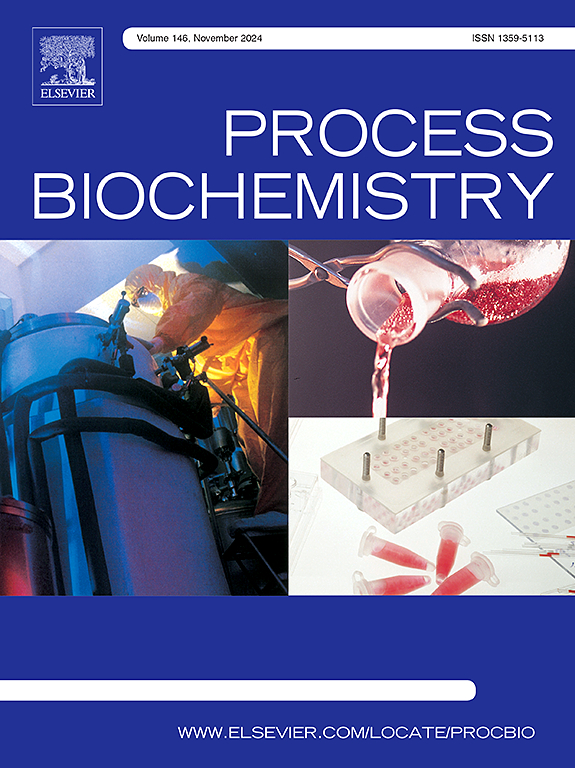Pathogen-targeting bismuth nanocluster via photothermally-mediated NDM-1 inactivation and bacterial membrane destabilization combat NDM-1-producing bacteria
IF 3.7
3区 生物学
Q2 BIOCHEMISTRY & MOLECULAR BIOLOGY
引用次数: 0
Abstract
New Delhi metallo-β-lactamase-1 (NDM-1) is the most prevalent type of metallo-β-lactamase and hydrolyzes almost all clinically used β-lactam antibiotics, including last line antibiotic - carbapenems. Inactivating NDM-1 and then reviving carbapenems holds great promise in treating NDM-1-producing bacteria, while better intracellular antibiotic accumulation and precise NDM-1 inactivation are challenges. Herein, a photothermal-assisted biomimetic antibiotic booster (PBM) is engineered for repurposing carbapenems against NDM-1-producing bacteria by photothermal-induced bacterial membrane destabilizing and synchronous NDM-1 inactivation. In the PBM nanomedicine, stomach medicine-converted bismuth nanoclusters (BiNCs) with excellent photothermal effect are used as photothermal skeleton, loading meropenem (MEM) on the inside and coating platelet membrane vesicles (PMVs) on the outside. Due to the inherent inflammatory properties of platelets, PBM exhibits an excellent homing effect on infectious sites and precise homologous targeting of pathogens. Meanwhile, due to the excellent photothermal properties of bismuth nanoclusters, PBM enhanced the intracellular accumulation of meropenem via breaking the bacterial outer membrane barrier, and then effectively inactivated NDM-1. Benefiting from the combination of photothermal-assisted bacterial membrane destabilizing and NDM-1 inactivation, PBM (100 μg/mL) effectively reversed the resistance of NDM-1-producing Escherichia coli to meropenem, exhibiting a more significant antibacterial effect (sterilization rate reached 98.9 %) than equivalent meropenem alone by time-killing curve.

通过光热介导的NDM-1失活和细菌膜不稳定对抗NDM-1产生细菌的病原体靶向铋纳米团簇
新德里金属β-内酰胺酶-1 (NDM-1)是最常见的金属β-内酰胺酶类型,几乎可以水解所有临床使用的β-内酰胺类抗生素,包括最后一线抗生素-碳青霉烯类。灭活NDM-1后再激活碳青霉烯类在治疗产生NDM-1的细菌中具有很大的前景,但更好的细胞内抗生素积累和精确的NDM-1灭活是一个挑战。本文设计了一种光热辅助仿生抗生素增强剂(PBM),通过光热诱导细菌膜失稳和同步NDM-1失活,将碳青霉烯类药物用于对抗产生NDM-1的细菌。在PBM纳米药物中,利用光热效果优异的胃药转化铋纳米团簇(BiNCs)作为光热骨架,在内部装载美罗培南(MEM),在外部包裹血小板膜囊泡(pmv)。由于血小板固有的炎症特性,PBM在感染部位表现出良好的归巢效应和病原体的精确同源靶向。同时,由于铋纳米团簇优异的光热性质,PBM通过打破细菌外膜屏障,增强美罗培南在细胞内的积累,从而有效灭活NDM-1。利用光热辅助细菌膜失稳和NDM-1失活的联合作用,PBM(100 μg/mL)有效逆转了产NDM-1的大肠杆菌对美罗培南的耐药性,从时间杀伤曲线上看,PBM的抗菌效果比同等剂量的美罗培南更显著(灭菌率达到98.9 %)。
本文章由计算机程序翻译,如有差异,请以英文原文为准。
求助全文
约1分钟内获得全文
求助全文
来源期刊

Process Biochemistry
生物-工程:化工
CiteScore
8.30
自引率
4.50%
发文量
374
审稿时长
53 days
期刊介绍:
Process Biochemistry is an application-orientated research journal devoted to reporting advances with originality and novelty, in the science and technology of the processes involving bioactive molecules and living organisms. These processes concern the production of useful metabolites or materials, or the removal of toxic compounds using tools and methods of current biology and engineering. Its main areas of interest include novel bioprocesses and enabling technologies (such as nanobiotechnology, tissue engineering, directed evolution, metabolic engineering, systems biology, and synthetic biology) applicable in food (nutraceutical), healthcare (medical, pharmaceutical, cosmetic), energy (biofuels), environmental, and biorefinery industries and their underlying biological and engineering principles.
 求助内容:
求助内容: 应助结果提醒方式:
应助结果提醒方式:


